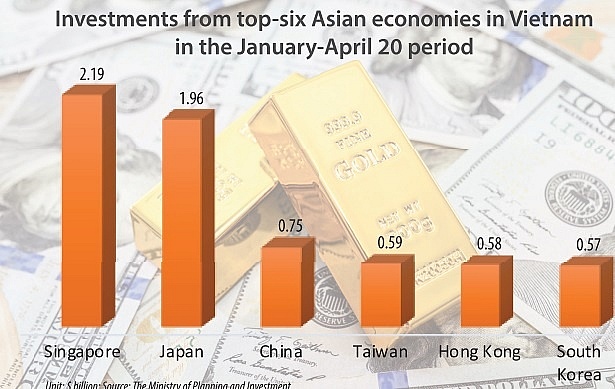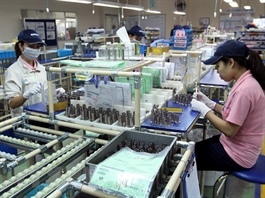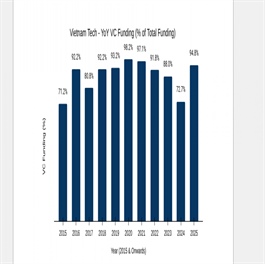CIT specifics address smaller firms
CIT specifics address smaller firms
Hundreds of thousands of micro- and small-sized enterprises in Vietnam will be entitled to a decrease in corporate income tax from this October, meaning more opportunities to ameliorate their competitiveness.
The Ministry of Finance (MoF) is seeking government approval of a decree detailing the Law on Corporate Income Tax (CIT), adopted by the National Assembly two months ago. As it stands, the decree is expected to be passed by the government this month and scheduled to take effect on October 1. It will apply for the period of calculating CIT in 2025.

A corporate income tax reduction would save smaller companies some cash, Photo: Le Toan |
According to the MoF, the decree is expected to create a firm legal framework for the implementation of the CIT law, boosting the domestic business climate in a more transparent manner, with more support provided for micro- and small-sized enterprises, and promotion of investment into the sectors of agriculture, technology, and environment.
One of the biggest highlights in the draft decree is that it covers some specific policies, such as the supplementation of regulations for the application of lower CIT. Under Article 10 of the draft, the CIT common tax rate is 20 per cent. However, a rate of 15 per cent shall be applied to micro-sized firms with total annual revenue not exceeding VND3 billion ($120,000), and a rate of 17 per cent shall be given to small firms with total annual revenue between that figure and VND50 billion ($2 million).
“The total revenue used as the basis for determining whether a business is eligible for the 15 or 17 per cent CIT rates includes total revenue from sales of goods, provision of services, financial activities, and other income as reported in the appendix on business performance results attached to the CIT finalisation return for the immediately preceding tax year,” the draft decree read.
Under the existing Law on Support for Small- and Medium-sized Enterprises, small enterprises refer to those which employ 10-49 people, and has a total annual revenue and total capital of VND50 billion ($2 million) and VND20 billion ($800,000), respectively. Micro-sized enterprises refer to those which utilise fewer than nine employees, and has a total annual revenue and total capital of VND3 billion ($120,000).
Businesses in the oil and gas industry are subject to CIT rates ranging 25-50 per cent, depending on each contract. Firms which engage in prospecting, exploration, and exploitation of certain mineral resources, including platinum, gold, silver, tin, and other rare and precious resources, are subject to a rate of 50 per cent.
Vietnam currenrly has nearly one million enterprises, of which as many as 97 per cent are micro, small, and medium-sized enterprises that are often cash-strapped and lack output markets, with weak competitiveness.
The country has set a target of two million enterprises by 2030, with efforts to be made for private enterprises to create 58 per cent of GDP, 40 per cent of state budget revenue, and 85 per cent of labourers.
In the first seven months of 2025, the number of businesses registering to halt performance hit 88,600, up 13.6 per cent on-year. Moreover, 41,500 enterprises halted operations to await dissolution procedures, up 16.7 per cent on-year; and 14,300 businesses completed such procedures, up 20.5 per cent on-year. On average each month, 20,600 enterprises left the market.
Nguyen Cong Bang, director of Cong Bang Foodstuff Co., Ltd. based in the outskirt of Hanoi, told VIR that currently like thousands of other enterprises, his company is faced with major difficulties.
“Prices of input materials like sugar, gas, beans, and cooking oil have increased by an average 15 per cent over the past seven months, while we still have to pay many types of taxes including a CIT rate of 20 per cent costing about VND25 million ($1,000) per month,” said Bang, whose company employs 40 people.
“If the CIT is reduced to 17 per cent, we can save about VND720,000 ($30) a month and VND8.64 million ($350) a year. The sum is not so big, but it is a testament to the state’s support to small-sized enterprises like us,” Bang said.
However, according to Tran Hai Van, director of Red Lotus Trading Co., Ltd. in Hanoi, specialised in trading home appliance products, there is an urgent need to reduce assorted taxes including CIT for smaller enterprises that are often vulnerable to shocks in the market. “For example, a CIT reduction can be offered to those with total revenue of below VND10 billion ($400,000) a year and this should be divided into different levels for application,” Van said. “For instance, a rate of 15 per cent is offered to a revenue of more than VND5 billion ($200,000) and a rate of 10 per cent is offered to a revenue of below VND5 billion ($200,000).”
- 10:51 22/08/2025



























